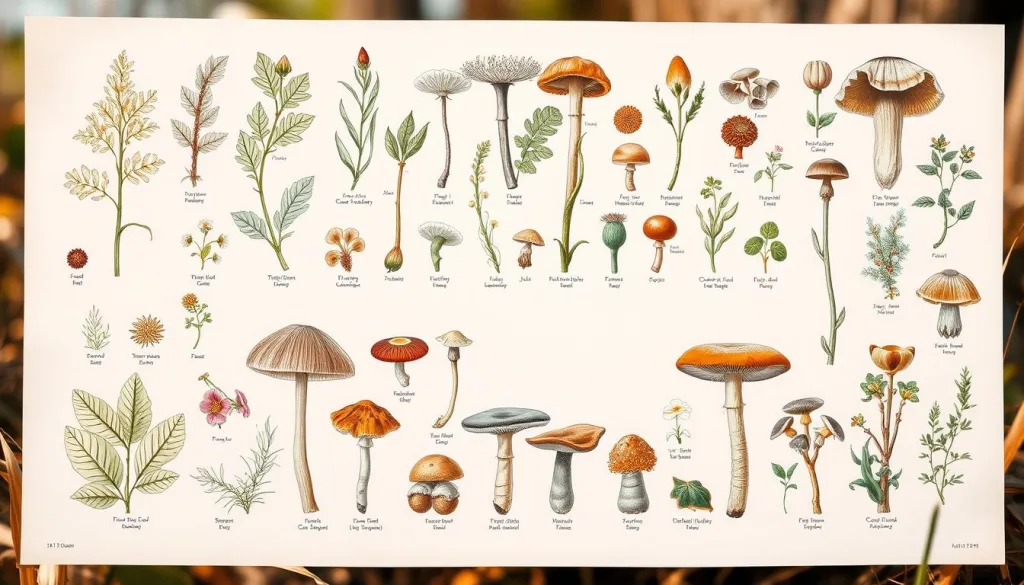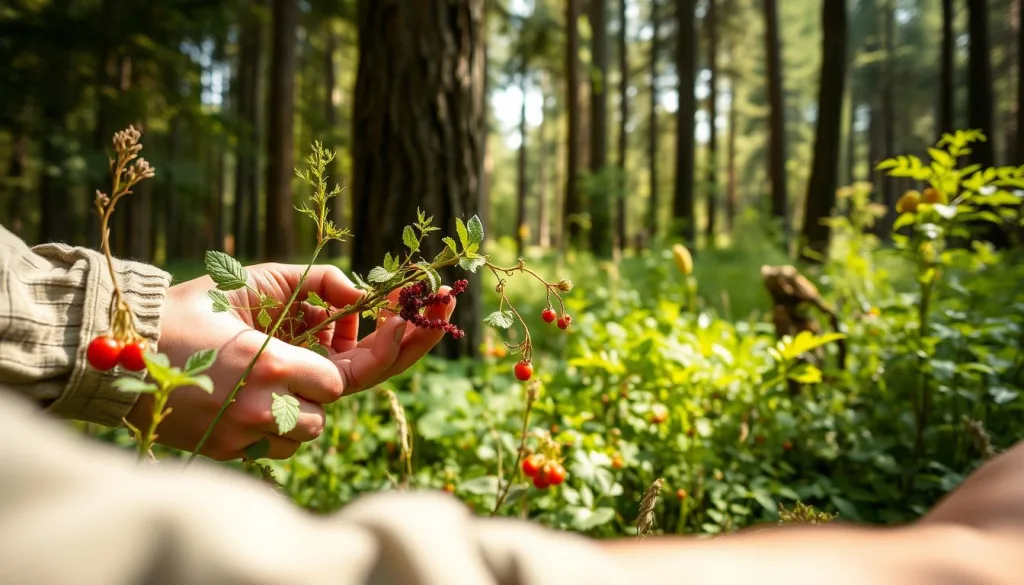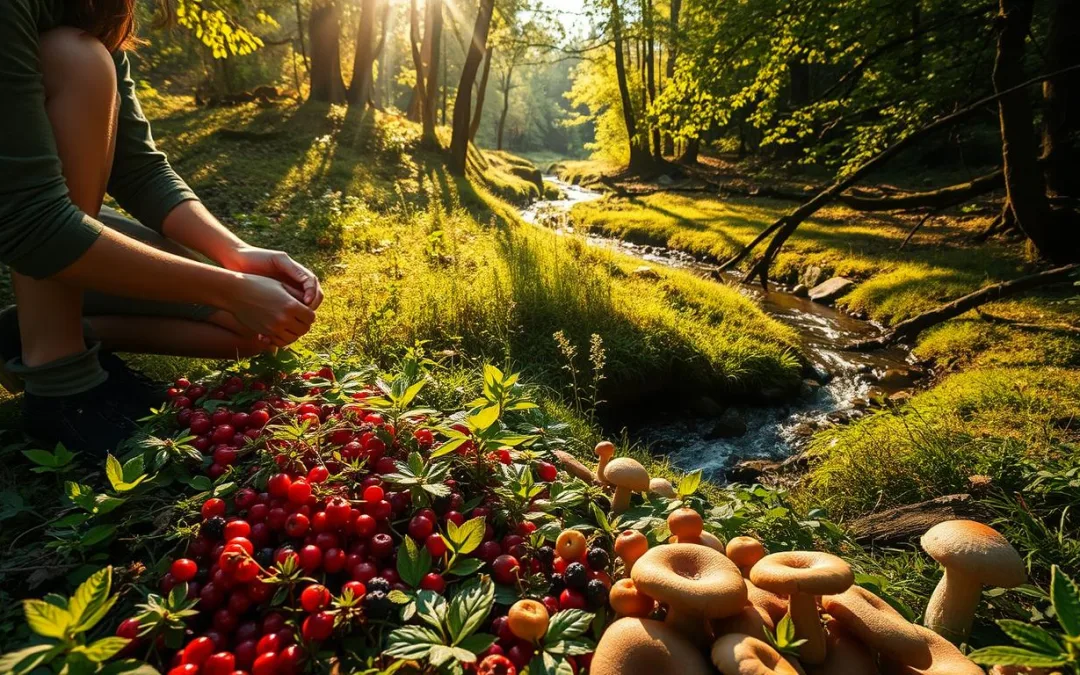Foraging for wild edibles is a journey into nature’s secret pantry. It connects us deeply with our surroundings, giving us healthy food instead of processed stuff. This ancient way of finding food turns walks into exciting adventures, showing us treasures we often miss.
Finding wild foods is more than just getting nutrients. It’s about learning about nature and our ancestors’ ways of finding food. Wild plants are often packed with more nutrients than the ones we grow. For example, wild spinach has more fiber, vitamins, and minerals than regular spinach.
Foraging needs careful knowledge and respect for nature. You must know how to identify plants, harvest them right, and be aware of dangers. Learning to spot safe plants lets you explore your area with confidence and wonder.
Key Takeaways
- Wild foods offer superior nutritional profiles compared to cultivated crops
- Foraging connects humans with natural ecosystems
- Proper identification and safety are essential skills
- Wild food gathering promotes environmental awareness
- Sustainable harvesting protects plant populations
Understanding the Basics of Wild Food Foraging
Wild food foraging connects us with nature by finding edible plants and fungi. It’s a sustainable way to eat and explore our surroundings. We can find amazing food right under our feet.
Learning to forage starts with respect for nature. It’s not just about finding food. It’s about caring for the environment and its balance.
What is Foraging?
Foraging means finding and eating wild plants, mushrooms, and other natural foods. Our ancestors used these skills to survive. Today, foragers connect with their primal roots.
- Identifies edible plants in natural environments
- Requires careful plant identification skills
- Promotes sustainable food gathering
Benefits of Wild Food Gathering
Foraging has many benefits beyond just food. Wild plants are often more nutritious than farmed ones. They offer great health advantages.
| Benefit | Description |
|---|---|
| Nutrient Density | Wild plants contain up to 3x more minerals and antioxidants |
| Sustainability | Reduces carbon footprint from commercial agriculture |
| Cost-Effective | Free nutritious food available in local environments |
Connecting with Nature Through Foraging
Foraging is more than finding food. It’s a deep way to understand nature. By learning to identify local plants, foragers develop a deeper appreciation for natural systems and biodiversity.
Remember, key foraging tips include: always know what you’re picking, take only a small part of a plant, and respect the environment. Knowing these rules keeps you safe and helps protect nature.
Essential Safety Guidelines for Foraging
Foraging for wild edibles needs careful preparation and strict safety rules. The journey of wildcrafting requires a detailed approach to keep you safe and avoid health risks. Knowing the basic foraging tips can make a big difference between a good harvest and a bad mistake.
Safety starts with knowing a lot and being well-prepared. Before you go foraging, remember these important guidelines:
- Always forage with an experienced guide or expert companion
- Invest in a reliable field guide specific to your local region
- Learn to positively identify plants using multiple sensory cues
- Start with easily recognizable edible plants
The foraging community has a key rule: “Never consume what you cannot identify with 100% certainty.” This rule is very important and can save your life by avoiding dangerous mistakes.
Being aware of your environment is also key to safe foraging. Stay away from areas that might be polluted, such as:
- Locations near busy highways
- Regions treated with pesticides
- Urban spaces with high pollution levels
- Private properties without explicit permission
Research shows that 75% of successful foragers suggest joining guided tours or workshops. These learning experiences can greatly improve your knowledge and safety. Also, about 80% of experienced foragers say it’s important to wear protective gear while foraging.
Remember: Your health and safety are the most important things in wild food gathering.
When you start foraging, learn about 5-10 local edible plants first. Eat small amounts at first to check for allergies. Always talk to an expert before eating any foraged food.
Getting Started: Best Tools and Equipment
Starting your wild foraging journey needs the right tools. Whether you’re new or experienced, the right gear makes foraging safe and fun. Check out this wild foraging guide for more tips.
Having the right tools is key to successful foraging. Here are the must-haves for every forager:
Basic Foraging Kit Essentials
- Knife: A folding knife with a blade under 3 inches, preferably with a brush for cleaning
- Mesh bags for collecting mushrooms and berries
- Foraging gloves to protect against thorny plants and skin irritants
- Portable hand trowel for digging underground edibles
- 10x magnification loupe for detailed plant identification
Storage and Transportation Tools
Good storage keeps your wild finds fresh. Here are some tools to consider:
- Multi-tiered drying rack (approximately 6 inches high)
- Dehydrator for preserving large quantities of mushrooms
- Waterproof containers for collecting and transporting wild edibles
- Insulated cooler for keeping delicate items fresh
Documentation Equipment
Tracking your finds is important for learning and safety:
- Waterproof notebook
- Metal ruler for precise measurements
- Digital camera or smartphone for plant identification
- GPS device for navigation in remote areas
Don’t forget a good wild foraging guide and field identification book. Quality gear and safety first are key for a great foraging adventure.
Identifying Common Edible Plants and Mushrooms

Learning to identify edible plants is key for wildcrafting success. Foragers must be very careful and detailed. It’s not just about looking at plants; you need to know them well.
Use all your senses when identifying plants. Some look-alikes can be dangerous. Experts say to use a multi-sensory approach:
- Look at leaf shape and feel
- Smell the plant’s unique scent
- Notice how it grows
- Check the flowers and fruits
- Compare with trusted field guides
Knowing plant families is important for safe foraging. Here are some common edible plants to know:
| Plant Category | Common Examples | Identification Tips |
|---|---|---|
| Wild Greens | Dandelion, Plantain | Distinct leaf shapes, no fuzzy or discolored leaves |
| Berries | Blueberries, Blackberries | Avoid plants with white or yellow berries |
| Mushrooms | Chanterelles, Morels | Unique cap and stem structures |
100% certainty is mandatory before eating any wild plant or mushroom. Wrong identification can be very dangerous. Always check multiple sources and join local foraging groups to get better.
“Knowledge is your best protection in the world of wild edibles.” – Experienced Forager
Begin with easy-to-spot plants in your area. Go to workshops, use apps, and keep learning to become a safe forager.
Seasonal Guide to Foraging for Wild Edibles
Foraging for wild edibles is a thrilling journey through nature’s seasonal pantry. Each season offers unique chances to find nutritious and tasty wild foods. By understanding local ecosystems, foragers can make the most of their finds and connect with nature.
Keeping a detailed foraging journal is key. It helps track seasonal patterns and improve your foraging skills. This way, you learn which plants are available at different times.
Spring Edibles: Nature’s First Harvest
Early spring is exciting for foraging. It’s filled with wild edibles waiting to be discovered. Some standout spring finds include:
- Chickweed: Extremely nutritious, often appearing before other green plants
- Hairy Bittercress: A mustard-green-like garnish
- Clover species: White and red clover are both edible
- Dandelions: Entirely edible, with roots that offer medicinal benefits
Summer Bounty: Abundant Wild Food Opportunities
Summer is a great time for foraging. Berries, herbs, and mushrooms are plentiful. It’s important to identify them correctly and harvest sustainably.
Fall Harvesting: Preparing for Winter
Autumn is the last chance to gather wild foods before winter. Mushrooms like oyster and morels are in season. Roots and late berries are also good for preserving through winter.
Winter Foraging Opportunities
Even in cold months, skilled foragers can find food. Winter foraging requires special knowledge and careful observation. It’s about finding dormant plants and evergreen resources.
Remember: Always prioritize sustainable harvesting and never collect threatened or protected species during your wild food foraging adventures.
Sustainable Harvesting Practices

Sustainable foraging is all about finding a balance. It’s about meeting our needs without harming nature. When we wildcraft, knowing how to harvest without harming plants is key.
The main rules of sustainable foraging are simple. They help us not harm the environment and respect plants. Here are the main points:
- Harvest no more than 10-25% of any plant population
- Carefully identify plant species before collection
- Understand the specific regeneration capabilities of different plant types
- Prioritize perennial plants with robust recovery mechanisms
Indigenous harvesting protocols, developed through thousands of years of landscape interaction, offer invaluable insights into sustainable wildcrafting practices. These traditional methods show how careful harvesting can help plants grow.
“Foraging is not about taking from nature, but participating in its complex ecosystem.” – Wild Food Expert
Each plant needs its own way of harvesting. For example, perennial plants like wild leeks can handle some harvesting. But annual plants need more care to grow back. Invasive plants like Japanese knotweed can be harvested more freely without harming the environment.
Sustainable foraging is more than just picking plants. It’s about knowing the local ecosystem, identifying plants correctly, and respecting their growth cycles. This way, foragers help both themselves and the environment.
Common Locations for Finding Wild Edibles
Exploring wild edibles requires a keen understanding of diverse ecosystems. As a wild foraging guide enthusiast, I’ve found that knowing safe and nutritious foraging spots is key. This knowledge is essential for successful wild food gathering.
Different environments offer unique wild food opportunities. Understanding these spaces helps foragers develop essential foraging tips. These tips are for finding nutritious plants safely.
Urban Environments: Hidden Foraging Treasures
Urban landscapes surprisingly host numerous edible plants. Suburban lawns and city parks can be rich sources of wild nutrition:
- Dandelions growing in lawns
- Wild onions in park edges
- Chickweed in disturbed soil areas
- Plantain along sidewalk margins
Woodland Areas: Nature’s Pantry
Forests provide abundant wild food resources for skilled foragers. Different woodland types offer unique edible plants:
| Woodland Type | Typical Wild Edibles |
|---|---|
| Deciduous Forests | Wild garlic, stinging nettle, lambs quarters |
| Coniferous Forests | Pine nuts, wild mushrooms |
| Mixed Woodlands | Hickory nuts, morel mushrooms |
Coastal Regions: Marine Edible Bounty
Coastal areas offer unique wild food experiences. Seaweeds and shore plants provide exceptional nutritional value. Careful identification is key to avoid toxic species.
Remember: Always obtain proper permission and follow local foraging regulations when exploring these diverse environments.
Legal Considerations and Permits
Foraging requires knowing local laws and respecting property rights. It’s key for foraging in a way that protects nature and property. This balance is essential for sustainable foraging.
Foraging laws change a lot from place to place. They differ a lot between public and private lands. Before you start foraging, you need to check the local rules. This helps you avoid legal trouble.
- Always get permission to forage on private land
- Look up the rules for public lands
- Know how much you can pick
- Follow the rules about when to pick plants
Foraging on public lands has its own set of rules. National parks usually have strict rules to protect the environment. They often don’t let you pick anything. National forests might let you pick some things, but you might need a permit.
Breaking foraging laws can lead to big problems. You could face:
- Big fines
- Legal trouble
- Loss of foraging rights
- Charges for trespassing
The U.S. Forest Service gives out many permits for picking wild foods. It shows how important it is to get the right permissions and know the local laws.
Remember: Sustainable foraging is not just about gathering food, but respecting the environment and legal boundaries.
Processing and Preserving Wild Edibles
After a successful foraging trip, it’s important to process and preserve your finds well. This keeps the quality and taste of wild edibles high. Using a food dehydrator helps dry ingredients efficiently, keeping them tasty and healthy.
Salt and pickling are great ways to keep food fresh longer. Salt curing keeps wild mushrooms safe and tasty in the fridge or freezer. Pickling adds unique flavors to foods, making wild recipes even better. Freezing is also good for berries, greens, and some mushrooms, keeping their color and nutrients.
Dehydrating is another good choice for preserving wild edibles. Dried items like Roasted Dandelion roots and Purslane can be stored for later use. Making infused oils and vinegars from foraged ingredients can also add a special touch to your dishes.
Knowing how to preserve different wild foods is essential. By using these methods, foragers can enjoy their harvest all year. This way, we stay connected to nature’s cycles through our food.
FAQ
What exactly is foraging?
Is foraging safe for beginners?
What are the most important safety considerations when foraging?
What basic equipment do I need to start foraging?
How can I learn to identify wild edible plants?
Are there legal restrictions on foraging?
What are the best seasons for foraging?
How can I practice sustainable foraging?
What should I do with my foraged foods?
Can I forage in urban environments?
Source Links
- Foraging for Wild Edibles and Herbs: Sustainable and Safe Gathering Practices – https://chestnutherbs.com/foraging-for-wild-edibles-and-herbs-sustainable-and-safe-gathering-practices/
- A Beginners Guide to Foraging for Wild Edibles With Kids – https://wilderchild.com/blogs/news/foraging-for-wild-edibles-with-kids
- Foraging for Beginners: Tips for Safely Gathering Wild, Edible Foods – https://www.gore-tex.com/blog/foraging-food-wild-plants
- Foraging: Ultimate Guide to Wild Food – https://www.wildedible.com/foraging
- Foraging for Wild Edibles: Tips for Finding Food in Nature’s Pantry – https://www.americanbackcountry.com/blogs/notes-from-the-trail/foraging-for-wild-edibles-tips-for-finding-food-in-natures-pantry
- Foraging: A beginner’s guide – https://www.bbcgoodfood.com/howto/guide/foraging
- How to Safely Forage | Institute of Culinary Education – https://www.ice.edu/blog/how-to-safely-forage
- Foraging for Food: Tips, Common Foods, Safety, and More – https://www.healthline.com/nutrition/foraging-for-food
- Foraging Basics and Safety Tips – https://slowlivingkitchen.com/foraging-basics-and-safety-tips/
- The Ultimate Foraging Gear List: Be Prepared For Anything — Year Of Plenty Podcast – https://www.theyearofplenty.com/blog/ultimate-foraging-gear-list-for-wild-plants-and-mushrooms
- [Video] The Forager’s Toolkit – Essential Equipment and Tools You Need for Wildcrafting – https://www.eatweeds.co.uk/toolkit
- Foraging for Edible Plants and Mushrooms While Hunting – https://www.divebombindustries.com/blogs/news/foraging-for-edible-plants-and-mushrooms-while-hunting?srsltid=AfmBOorL6JyONKGnPMtbVSB1yFFCDcGTBcBLbSNCUshvwrNrwdhJjxSN
- Edible Wild Plants and Mushrooms – Recipes and Guides | Hank Shaw – https://honest-food.net/foraging-recipes/
- Beginner’s Guide to Identifying Wild Edibles – https://slowlivingkitchen.com/identifying-wild-edibles/
- Foraging in Early Spring: Wild Edible Plants to Gather Now — Good Life Revival – https://thegoodliferevival.com/blog/foraging-spring-wild-edible-plants
- Foraging for wild foods – https://www.michigan.gov/dnr/things-to-do/foraging
- Foraging and Harvesting Indigenous and Wild Plants Best Practices – https://www.usda.gov/sites/default/files/documents/foraging-harvesting-indigenous-wild-plants-best-practices.pdf
- Foraging for Wild Food: 6 Sustainable Techniques – https://www.sierraclub.org/sierra/2013-4-july-august/green-life/foraging-wild-food-6-sustainable-techniques
- Nature Provides: Edible Wild Plants You Can Forage in the USA – https://www.kuhl.com/borninthemountains/edible-plants-on-the-trails-in-usa?srsltid=AfmBOopntxV2rLfXqnLamkJFFwhdA8_LzEmLChJdaGKK1COC3lyXp263
- Wild Edibles: Superfoods in Your Own Backyard – https://www.thepaleomom.com/wild-edibles-superfoods-in-your-own-backyard/
- Foraging: Ultimate Guide to Wild Food – https://www.wildedible.com/index.php/foraging
- 14 Essential Foraging Laws: Wild Food Gathering Regulations Guide – https://www.foragefinds.com/stream/14-foraging-laws-you-need-to-know/
- Food Law Gone Wild: The Law of Foraging – https://ir.lawnet.fordham.edu/cgi/viewcontent.cgi?article=2740&context=ulj
- 10 Methods to Preserve Wild Edibles – https://slowlivingkitchen.com/preserving-wild-edibles/
- The Wildly Preserved – https://wildblessings.com/the-wildly-preserved/


